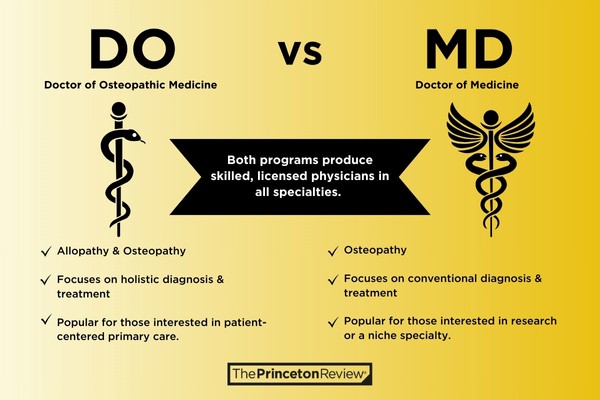There are two distinct degrees to choose from on the path to becoming a licensed physician, and at some point, students following that career will need to compare DO vs MD and decide if they want to be a Doctor of Osteopathic Medicine (DO) or a Doctor of Medicine (MD).

What is the main difference between DO and MD programs?
Both DO and MD programs prepare graduates to diagnose and treat disease. However, they differ in their approach:
MD Programs: Focus on conventional medicine, emphasizing disease treatment through medication, surgery, and other established therapies.
DO Programs: Utilize a holistic approach to health and disease prevention that emphasizes the integrated nature of the skeletal, muscular, and neurological systems.
How competitive are match rates for each program?
As of 2020, both DO and MD graduates participate in the same National Residency Matching Program (NRMP) to select a residency or internship to continue their training after medical school.
Graduates of DO and MD programs are competitive throughout the match process. In 2023, fourth-year medical students completing their training experienced the following match rates:
- Students completing their DO had a 91.6% match rate success.
- Students completing their MD had a 93.7% match rate success.
Regardless of the type of program, over 90% of graduates went on to continue their training toward becoming a licensed physician.
As a result, career outcomes for students of DO and MD programs in recent years have been largely the same: both programs produce skilled, licensed physicians in all specialties.
Are DO programs becoming more popular?
To keep up with the demand for primary care physicians in the United States, DO programs have flourished in recent years; the American Medical Association reports a 68% increase in enrollment in DO programs between 2012 and 2022.
The average acceptance rate to allopathic medical programs is approximately 40% of all applicants. With U.S. residency programs accepting applicants from both DO and MD programs, applying to both can increase the chance of receiving an acceptance during your application cycle.
Why get a DO instead of an MD?
Many students are attracted to DO programs because they want to practice patient-centered primary care. As of 2021, 57% of DOs practiced in primary care specialties, including:
- family medicine
- internal medicine
- pediatrics
Although admission remains challenging, DO programs are generally considered slightly less competitive than MD programs. So, if your GPA or MCAT scores are marginally lower, DO programs might be a good option for increasing your chances of acceptance.
If you haven’t already, take a free MCAT practice test to see what your starting score is.
Why get an MD instead of a DO?
If you’re interested in medical research or a particularly niche specialty, a DO may not be the right choice for you. Although essentially all residency programs accept both MD and DO applicants, do as you did when applying to medical school and always research your targeted residency programs thoroughly to ensure you meet all their requirements and restrictions.
DO vs MD Programs
| MD Program | DO Program | |
|---|---|---|
| What Is It? | A graduate school that prepares highly trained physicians | A graduate school that prepares highly trained physicians |
| What does it stand for? | Doctor of Medicine | Doctor of Osteopathic Medicine |
| What’s the difference? | Focuses on diagnosis and treatment | Focuses on diagnosis and treatment with particular emphasis on holistic health and prevention, as well as osteopathic manipulative medicine or OMM |
| Prerequisites | Four-year undergraduate degree, including pre-med coursework Average matriculate GPA: 3.75 Average matriculate MCAT score: 512 |
Four-year undergraduate degree, including pre-med coursework Average matriculate GPA: 3.6 Average matriculate MCAT score: 505 |
| Graduate School Experience | Two years of academic instruction Two years of field experience |
Two years of academic instruction Two years of field experience |
| What comes next? | Participate in the National Residency Matching Program to continue on to a residency/internship of choice | Participate in the National Residency Matching Program to continue on to a residency/internship of choice |
| What are likely career outcomes? | A career as a physician. More opportunity to specialize. | A career as a physician with an opportunity to specialize. Many practice patient-centered, primary care. |
For many medical school applicants, the individual aspects of the medical programs they’re interested in (location, areas of specialty, competitiveness of the application process) will weigh more heavily in their graduate school admissions decision than whether or not the program offers an MD or DO degree.
DO vs MD: Who makes more?
Many people assume that MDs will make significantly more than DOs. In reality, a physician’s salary is more influenced by their specialty, level of experience, and geographic location rather than their degree.
So, when considering DO vs MD, one is not better than the other. They are both great options for those wanting to practice medicine.
Explore Graduate Programs for You
Explore our featured graduate schools & programs to find those that both match your interests and are looking for students like you.
Best Law Schools
Check out our complete list of 168 law schools, based on surveys of school administrators and over 17,000 students.
Search for Medical Schools
Visit our Med School Hub to explore med schools with our ‘Find Your Med School’ filtered search or visit our Med School Advice pages for info about good MCAT scores or interview question prep.

Find MBA Programs Matched to Your Interests
Explore our featured business schools to find those that are looking for students like you.


